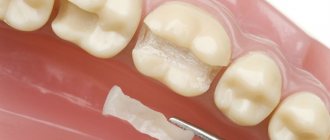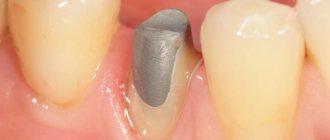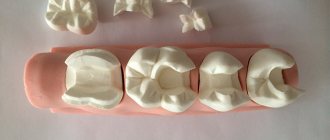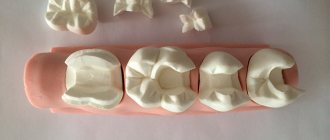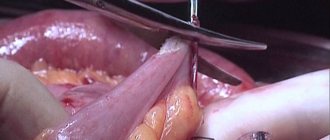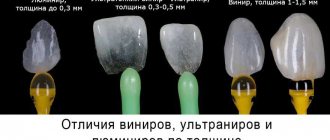In this article, we will consider situations when a filling can be installed on a tooth, and in which cases it is better to give preference to a ceramic tooth inlay.
Caries is the most common dental disease for which people go to the dentist. It is ideal if it is possible to identify caries at the earliest stage of its development. But this is not always possible for various reasons. Caries occurs not only on a tooth that has not been treated, but secondary caries can also develop under a previously installed filling. Sometimes this destructive process develops so secretly that it is simply impossible to visually determine it yourself. Meanwhile, tooth tissues are affected more and more over time. In order to prevent such development of the disease, it is necessary to regularly use dental services for preventive examinations once every six months. A specialist during an examination will always be able to identify the presence of a disease using a visual examination and various modern methods of x-ray diagnostics.
The classic restoration of a tooth after treatment is the placement of a filling in a prepared cavity. But this method is good if there is a small cavity. When most of the tooth is destroyed, it is better to restore such a tooth with a ceramic inlay.
How does an inlay differ from a filling?
The filling is made of a plastic material that hardens and takes the desired shape. It is made and installed right in the dentist's office in one appointment. However, a filling will not help when the tooth is severely damaged. In this case, you will need a ceramic inlay. It is made in the laboratory using an individual impression. It not only closes the resulting cavity, but also exactly repeats the shape of the destroyed area of the crown.
Advantages over fillings:
- Higher efficiency
. It is possible to restore a severely damaged tooth. A filling is suitable only if the cavity occupies less than a quarter of the crown, and an inlay can restore from 25 to 60%; - Naturalness
. The inlay imitates the anatomical shape of the chewing surface. It is almost invisible, while the filling can be seen; - Higher strength
. Microprostheses do not develop cracks. A filling of this size would quickly crumble, so it is not suitable for restoring extensive damage; - Durability
. The tab will last 5–7 years. At the same time, it will remain unchanged and will not lose its original characteristics; - Ensuring the prevention of secondary caries
. Sometimes the filling can become infected again. The insert fits very tightly and does not shrink over time, so this risk is eliminated; - Color fastness
. The fillings have a porous structure, so they are easily stained by tea, coffee, and tobacco. Ceramics are not subject to color changes.
Flaws:
- They cost more;
- They take longer to produce. The filling can be placed in one visit to the dentist. And to install the tab, you will need 2 visits with a break for the manufacture of a microprosthesis in the laboratory.
Advantages and disadvantages
Ceramic inlays have both advantages and certain disadvantages. The doctor must take them into account when installing. The advantages include:
- high aesthetics of the design, which lasts for a long time;
- ideal compatibility with dentures and crowns;
- low abrasion of tooth enamel;
- the tabs do not darken or change color when exposed to food coloring;
- with their help you can seal even large holes in fabrics;
- the appearance and functions of the tooth are completely restored after installation of the products;
- They are far superior in strength and durability to dental fillings.
Disadvantages include the high cost of products and the duration of their installation. To fix the microprosthesis, you will have to visit the doctor several times.
The price of the structure is several times higher than the cost of the filling, but in the future it pays off. This is explained by the fact that the first one will last for many years, and the second one will have to be changed more often. Another advantage of ceramic inlays is that they reliably protect the tooth from recurrent caries. The same cannot be said about fillings.
When installing a microprosthesis, there is a risk of complications. When preparing a tooth for an inlay, its hard tissues are excised so that the cavity takes on the desired shape. People suffering from hypersensitive teeth experience discomfort.
After installation, over time, secondary caries may occur at the installation site, as a result of which the insert may fall out of the tooth. If this happens, you need to urgently visit the dentist who performed the fixation. If the tab is not lost, then you need to take it with you, and the doctor will put it in its place. Otherwise, the microprosthesis will have to be made anew, which will entail financial costs and loss of time.
Indications
The main use case is the treatment of caries. A ceramic inlay for a tooth is needed if its crown is destroyed by 25–60%. If the cavity occupies less than a quarter of the surface, then you can get by with a filling, but if more than 60%, then a crown is needed. Other indications for installation:
- Destruction of non-carious origin;
- The need to install a bridge prosthesis (microprostheses are placed on abutment teeth to increase their strength);
- Increased abrasion of enamel.
Stump inlays: what do you need to know about them?
At the very beginning of our article, we said that stump inlays should not be confused with restorative microprostheses - they are used to restore pulpless and severely damaged teeth, in which they will serve as the basis for installing a crown or dental bridge.
Stump inlays are structures consisting of two parts: a pin installed in the root canal and a support on which the crown will be fixed. Stump inlays can be monolithic or collapsible, and most often this type of structure is used when the tooth has less than 50% of healthy tissue left.
Many people are interested in the question: why is it best to use core inlays rather than fillings on a pin to restore severely damaged teeth? The fact is that the pin may not withstand the load and begin to wobble in the canal, and this will either lead to the filling breaking or falling out, or, worst of all, to damage to the tooth root, in which the tooth is most often removed. Stump inlays allow you to avoid such risks because they distribute the load more correctly and themselves have much greater strength compared to pins.
Stump inlays are also made in the laboratory and the construction material is selected to match the type of dental crown that is planned to be placed in the future. Metal core inlays are used for metal-ceramic crowns, and zirconium inlays are used for ceramic crowns. If you make a metal inlay for a ceramic crown, it can shine through the thin and transparent material of the crown, which will have a bad effect on the aesthetics of the restoration.
Tooth restoration using a core inlay will also be divided into several stages: diagnostics, preparation, during which a cavity is formed in the tooth for the inlay, manufacturing of the inlay, and its installation. After installing the core tab, the crown is fixed on it and this completes the process of tooth restoration.
If the tooth is destroyed, but there is a living nerve in it, before installing the stump tab, depulpation is carried out, as well as treatment and filling of the root canals. It is important that these procedures are carried out without errors, since poor canal processing leads to various kinds of complications, the elimination of which requires complex and lengthy treatment.
Contraindications
This type of microprosthesis cannot be installed in the following cases:
- bruxism (grinding teeth in sleep);
- steep slopes of hillocks;
- rapidly progressing caries;
- deep cavity extending into dentin;
- inability to ensure complete dryness of the field.
A relative contraindication is poor oral hygiene. In what cases is it not advisable to use:
- A cavity less than 1.5 mm deep (you can get by with a filling);
- The damage has affected the cervical area of the tooth (the inlay will no longer help);
- The tooth is more than 60% destroyed (a crown is required);
- Milk tooth. It makes no sense to restore it using an inlay, since the life of the tooth is less than the durability of the microprosthesis. In addition, a vlkadka costs much more than a filling. Spending so much money to restore a tooth that will soon fall out is not advisable.
When is a filling needed?
If less than a third of the tooth is damaged, then in most cases the doctor restores it using filling materials. Modern photopolymer fillings
allow you to recreate the shape and color of a natural crown, add aesthetics to the surface, and adjust the position of the unit.
But in case of serious damage, a large filling is often (!) placed in the cavity, which will not withstand long-term significant loads. If a tooth has been depulped, then over time its walls become fragile and further destruction occurs. When the carious cavity is large, restoring the destroyed tooth crown with a regular filling is acceptable, but does not guarantee long-term preservation.
Types of tabs
Depending on the material of manufacture, they come in the following types:
- metal-ceramic
- the most budget-friendly; - ceramic
– the most aesthetic; - made of zirconium dioxide
- the most durable.
These microprostheses are also classified depending on their position in the tooth. According to this criterion, the following varieties are distinguished:
- Inlay
– the hole in the tooth is box-shaped, the inlay is installed inside it; - Onlay
– the overlay has an external side; - Overlay
– only one wall is preserved, the overlay replaces almost the entire crown; - Pinlay
– the inlay has additional cavities or pin inclusions for better fixation.
The type of inlay based on its position in the tooth is selected by the dentist after an initial consultation.
Types of products
Experts distinguish between two main types of orthopedic structures: stump and restorative. A ceramic core inlay is required to restore the tooth core for subsequent fixation of the crown. Most often it is used for prosthetics of incisors. Restorative structures are used for chewing teeth when one or two surfaces are damaged. In addition to high aesthetics, they are characterized by reliability and durability. Also, the tabs are distinguished by the material used. Below are the most common materials from which products are made.
- pressed ceramics. Products are produced using porcelain injection molding. The procedure is carried out under conditions of high temperature and pressure. Compared to orthopedic structures made of metal or zirconium dioxide, they are not as durable, but are ideal from an aesthetic point of view;
- zirconium dioxide. They are made by grinding finished metal oxide blanks. Grinding is carried out automatically using a ready-made impression (plaster model) of a damaged molar or premolar. Thanks to computer control, finished structures are characterized by high quality. Upon completion, the workpiece is fired, fusing the porcelain mass. Zirconium dioxide is a high-tech material for orthopedic structures, and therefore is in special demand. From an aesthetic point of view, such inlays are in no way inferior to porcelain products, and in terms of strength they are not inferior to metal products;
- metal. The metal most often used is gold or a silver-palladium alloy. Such designs are reliable, but do not have high aesthetics;
- metal ceramics. This is the latest orthopedic design, which is distinguished by high aesthetics, but at the same time cannot boast of proper quality. Due to thermal exposure, such products often fall out of the mouth. Most experts advise installing a structure made of zirconium dioxide or pressed ceramics rather than metal ceramics.
The process of manufacturing and installing inlays on a tooth
Dental prosthetics is performed in several stages:
- Initial consultation
. The doctor assesses the extent of destruction and draws up a recovery plan; - Hygienic teeth cleaning
if necessary; - Selection of the required shade
to match the enamel color; - Removal of tissues affected by caries
, if the destruction was caused by this disease; - Taking an individual impression
, according to which a microprosthesis will be made; - Closing the cavity with temporary material
for the waiting period; - Making an inlay
based on an individual impression in a dental laboratory; - Installation
of the inlay and its fixation using special dental cement.
Thus, a tooth can be restored in 2 visits to the clinic. The first visit is a consultation, treatment of caries and taking an impression, the second is the actual installation.
Indications and contraindications for installation
Indications for tooth restoration using a ceramic microprosthesis:
- The need to restore chewing teeth that have a significant cavity formed as a result of caries or trauma, when it is impossible to eliminate the defect with filling. The technique is perfect even in cases where it is necessary to restore up to 50% of damaged tooth tissue.
- We are talking about replacing old large fillings. The need for tissue preparation, which involves the refilling procedure, will further enlarge the existing cavity and thin the walls of the tooth. Under such conditions, installing a new seal will not ensure reliability.
- There is a pathological abrasion of tooth tissues and, as a consequence, their destruction. Ceramics, which have increased strength, can completely prevent the loss of hard tissues due to their abrasion.
- Cases where the destruction of the coronal part of the tooth is great, it is possible to avoid depulping and covering the tooth with a crown.
You will have to refuse to use a ceramic inlay in the following cases:
- More than half of the destroyed tooth tissue needs to be restored. In this case, the only possible solution to save the tooth and avoid its removal is filling and subsequent installation of a crown.
- We are talking about baby teeth or numbers of eights. With such extensive damage to the wisdom tooth, surgical tactics are taken as the basis; removal will be required.
The main differences between a filling and a ceramic inlay
A ceramic inlay differs from a filling in a number of ways:
- The material from which ceramic inlays are made is similar in physical and chemical properties to natural tooth tissue, due to which microprostheses are significantly superior to any type of filling in terms of strength and resistance to abrasion.
- Regarding aesthetics, the ceramic inlay looks completely identical to the tooth tissues, matching them in color and transparency. At the same time, the filling may have a different shade.
- The inlay is used to restore chewing teeth with significant tissue defects. The filling is used for small, no more than 30%, affected areas, which is associated with insufficient hardness of the material. If you try to install a larger filling, it will not be possible to ensure a sufficient quality of its fit, which will lead to the risk of reoccurrence of caries. At the same time, if all preparatory measures were carried out correctly, a ceramic onlay will reliably avoid such complications.
- In terms of service life, ceramic inlays have clear advantages. If a filling guarantees preservation of the result for about 5 years, then with the help of a microprosthesis you can expect that the tooth will last over 10 years.
- If a filling is made directly in the patient’s mouth by a dental therapist, then ceramic microprostheses are created in the laboratory, and the entire process is controlled by an orthopedic dentist. The course of treatment takes longer, but thanks to the technological features of the technique, the specialist has the opportunity to install a microprosthesis more tightly than a filling.
- The method of restoring a tooth using a ceramic inlay is more expensive. However, this conclusion is not absolute, since in the long term the patient receives a more reliable and durable restoration result.
Types of tabs
Today, the most popular classification of ceramic inlays, developed by the American Dental Association ADA, is considered. According to it, the following types of tabs are distinguished:
Inlay – a microprosthesis is fixed inside the tooth. In this case, restoration of the tubercles is not expected; the tab is, as it were, sandwiched between them. Such features ensure its high functional performance and viability. However, these clinical prerequisites make it possible to use a filling quite successfully, so specialists take an extremely balanced approach to choosing an inlay.
Onlay - this option of an inlay is used if one or more cusps of the tooth are destroyed and need restoration. By using an inlay, some of the cusps on the tooth remain their own, and some are replaced with a ceramic microprosthesis. However, when carrying out a chewing load, an overturning moment may occur, which negatively affects the fixation of the structure. Only a specialist’s impeccable knowledge of the anatomy of the dentofacial system, thorough diagnostics and impeccable precision in the execution of work can ensure the required quality of restoration carried out using this method.
Overlay is an option in which the inlay covers all the cusps of the tooth, which ensures maximum fastening strength. In such a clinical case, the doctor will be faced with a dilemma whether to use an inlay or perform additional grinding of the tooth and install a crown.
Pinlay is a special version of the inlay, which involves the presence of a pin in its design, with the help of which better fixation of the entire structure is ensured. This option is suitable for any type of inlay, on any tooth.
How a ceramic inlay is created for teeth
The production of a ceramic inlay goes through several stages:
- If necessary, the doctor removes the remains of old fillings, damaged tooth tissue, smoothes the walls of the cavity, which will ensure high-quality impressions and, in the future, a tight fit of the inlay. Then the resulting cavity is treated with medication.
- Taking an impression. Since the inlay is a microprosthesis, it is to the dental laboratory that the finished impressions are sent.
- The laboratory stage assumes that, based on the impressions obtained, the dental technician casts a plaster model, and then restores the lost part of the tooth using ceramic mass. The process consists of applying the material in thin layers and sequential firing in a special oven, where, in addition to high temperature, about 700 degrees, vacuum conditions are created. The color of the ceramic microprosthesis is selected individually, taking into account the basic tone of the patient’s enamel. The created product is carefully polished and handed over to the doctor. The use of ultra-precise technology and computer modeling techniques allows us to take this technology to a new level, significantly increasing the quality of the resulting product and the compliance of the microprosthesis with the cavity being restored. When creating an e.max Press ceramic inlay, standard impressions are not required. The doctor will receive the necessary information by scanning the tooth, nearby and opposite areas using a compact 3D camera. The software will be used at each subsequent stage, when creating a virtual model of a tooth, an inlay, as well as when turning a real model on a special milling module connected to a computer. By making an inlay using this method, using computer technology, the impeccability of the result will be guaranteed.
- At the patient’s subsequent visit, the doctor tries on the finished microprosthesis. The specialist evaluates the fit of the tab and the contact with neighboring teeth. If no modification is required, attach it to the tooth using adhesive material.
Considering this entire multi-stage technological process, it becomes clear that such a complex design cannot be used inexpensively. In addition to direct manufacturing and payment for the services of a dental technician, the cost of diagnostics, tooth processing, taking impressions, selection of shape and color, and the purchase of expensive materials and ceramic mass are also involved in determining the price. Will increase the final cost and use of digital technologies.
Advantages and disadvantages of products
Ceramic inlays are significantly superior in quality to composite fillings. And this is due, on the one hand, to the physical and chemical properties of the material, and on the other hand, to the peculiarities of creating microprostheses. Based on these features, the advantages of ceramic inlays are:
- High manufacturing precision, which minimizes the risk of developing recurrent caries, guarantees the reliability of restorations and extends the life of the tooth. In fact, the inlay and the tooth become one. As a result of life activity, your own enamel is more likely to be destroyed than a ceramic inlay.
- Excellent aesthetic characteristics. Inlays are exactly identical to natural tooth tissue in appearance.
- High wear resistance. Ceramics are not subject to staining with food dyes and exposure to aggressive substances in the oral cavity.
- Lack of special care. It is enough not to ignore daily standard hygiene procedures and visit the dentist in a timely manner for a preventive examination and professional teeth cleaning.
Where is the best place to install ceramic inlays?
Considering the high costs of installing a ceramic inlay, the question of where it is best to carry it out is not idle. To fully obtain an aesthetic, reliable and long-term result, you need to use the services of the most qualified specialists who have extensive practical experience in installing such orthopedic structures. The specialists of the Dental Studio clinic in Moscow are the best solution.
Our dentists constantly, every day, prove their professionalism with the high-quality results of their work. Success is fully guaranteed when installing ceramic inlays. Using this technique, you can extend the life of a decayed tooth without installing a crown.
Pros of ceramic inlays
A ceramic tooth inlay has many advantages:
- High strength
. An inlay, unlike a filling, significantly strengthens the tooth. Therefore, it is the preferred option if the tooth in which it is installed will be used as a support for a bridge; - Good aesthetic properties
. Ceramics are translucent, so they successfully imitate the natural color of the tooth. It also exactly follows the normal shape of his crown; - The ability to fully restore the chewing surface
. The inlay completely follows the anatomical shape of the tooth. This provides convenience when eating; - Hygiene
. Glaze is applied to the tab as a finishing layer. It creates a glossy surface on which plaque does not accumulate; - Resistance to external factors
. Ceramics does not darken over time, does not change color due to smoking or drinking coloring drinks; - Durability
. A ceramic inlay will last longer than a filling – 5–7 years. There are also more durable inlays, for example, made of zirconium dioxide, but ceramic ones are more aesthetically pleasing compared to them; - No risk of secondary caries
. Inlays, unlike fillings, do not shrink and adhere tightly to the tissue. This eliminates the possibility of cracks and the development of secondary carious lesions; - Easy replacement
. When installing a new inlay after its service life has expired, there is no need to grind the tooth again. Caries does not develop under a microprosthesis of this type, so there is no need to remove the affected tissue. - Bioinertness
. Ceramics does not absorb or accumulate any odors. There is no plaque deposited on it; - Hypoallergenic
. Microprostheses made of pure ceramics do not cause any immune reactions; - No need for special care
. Regular hygiene rules are sufficient.
Why should you contact TriDental dentistry?
The most painful process during prosthetics is the grinding of bone tissue; the patient feels discomfort, but not pain, since the process is carried out under local anesthesia. First, the dentist cleans the oral cavity and removes plaque and tartar, after which an x-ray is taken, impressions are taken, and an antiseptic treatment is performed.
Many years of experience and equipping the clinic with modern European equipment allowed us to select the most effective and painless treatment methods. Our advantages:
- low prices for ceramic tooth inlays;
- use of high-quality anesthesia;
- individual approach to each patient;
- All services are guaranteed!
To clarify details or make an appointment for the installation of ceramic crowns and inlays, you can always contact our employees for help by phone or through the feedback form on the official website.
